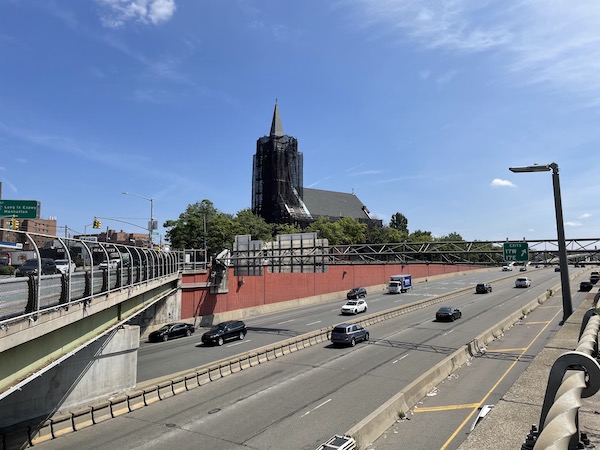
LONG ISLAND CITY — Father Paul Kim, pastor of St. Raphael Church in Long Island City, estimates that 250,000 people pass by his church every single day. That sounds like a big number — until you consider the fact that the church sits next to the Long Island Expressway.
“I don’t need an alarm clock anymore,” he said, explaining that noise from the expressway starts every morning at 6 a.m. when people begin heading to work. “I got used to the noise. But it’s always interesting,” he added.
With 250,000 people getting a view of his church — albeit briefly — as they drive past on the highway, Father Kim said he wants to give them something beautiful to see.
That goal is on its way to being fulfilled. St. Raphael Church is undergoing an ambitious $2 million renovation project that involves repairing its roof and replacing many of the exterior bricks on its Gothic-inspired building, which was constructed in 1881 and is one of the oldest Catholic churches in Queens.
The bulk of the funding for the renovation has already been raised, thanks to a capital campaign spearheaded by Father Kim’s predecessor, Father Jerry Jecewiz, the church’s former pastor.
But the church is also getting some help with a small portion of the project, thanks to a $20,000 grant from New York Landmarks Conservancy, a nonprofit organization that works to preserve historic buildings around the state.
The grant — awarded under the conservancy’s Sacred Sites program — is being used to renovate the church’s spire, a 154-foot-tall structure that is visible even from a mile away.
St. Raphael Church is one of 22 sacred sites to be awarded a grant this year. Under the program, churches receive funds for capital projects, along with technical assistance from preservation experts.
Father Kim, who applied for the grant at the suggestion of a project manager from Zaskorski & Associates, Architects, the firm responsible for the restoration plans, said he is grateful for the funds.
Since the inception of the Sacred Sites program in 1986, the conservancy has awarded 1,600 grants to 840 religious institutions.
Right now, the church is covered in scaffolding, but Father Kim expects that to be removed in late September.
“The main focus of the building mission is to make sure that the building lasts another 50 to 100 years,” he explained. “That’s our goal.”
Richard O’Connor, a parish trustee, said he is impressed with the work so far, including the removal of exterior plates that covered the church’s stained glass windows.
While the renovation project is a source of pride for parishioners, the feelings run deeper, he said. “You’re a part of history because the church belongs to all of us,” he explained. “We’re all pillars of the church. So are all the people that went ahead of us and all the people that are going to come after us.”
However, St. Raphael Church didn’t get the grant just because it’s a beautiful old building. Ann Friedman, director of the Sacred Sites program, said the conservancy deliberately selects religious institutions that do more than serve their own congregations. In other words, institutions that reach out to their surrounding communities.
“We find that most churches are serving at least 10 times their member numbers with cultural, community, and social services and education programming,” Friedman explained.
St. Raphael Church, which reflects the diversity of Long Island City by celebrating Masses in three languages — English, Spanish, and Korean — certainly fits the bill, Friedman said.
The church, which has approximately 600 parishioners, doubles as a community center and performing arts space, operates a food pantry that feeds 200 people a day and offers ESL classes as well as classes for the developmentally disabled.
Once the construction work is done, Father Kim said he and his parishioners will look forward to their next major project: renovating the church’s interior.
